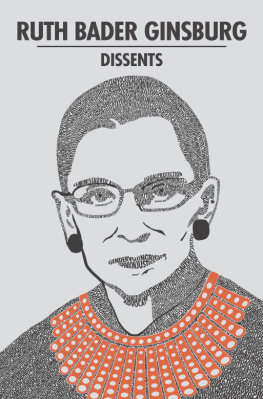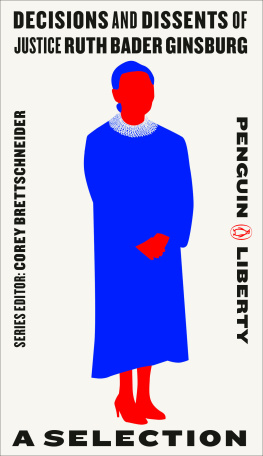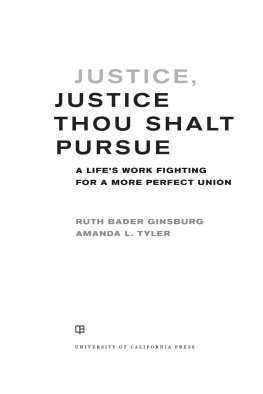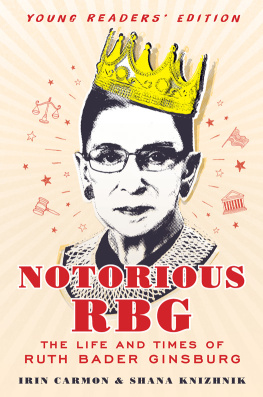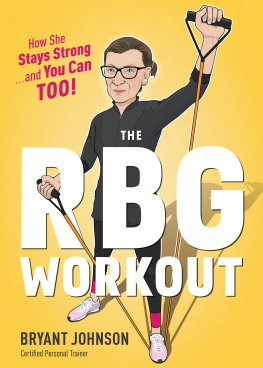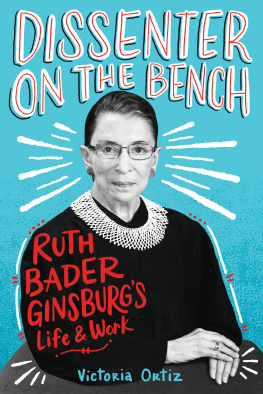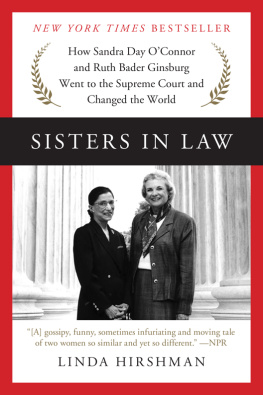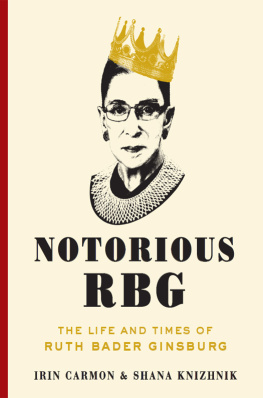In 1971, for the first time in our Nations history, this Court ruled in favor of a woman who complained that her State had denied her the equal protection of its laws. Reed v. Reed, 404 U.S. 71, 73 (holding unconstitutional Idaho Code prescription that, among several persons claiming and equally entitled to administer [a decedents estate], males must be preferred to females).
U.S. Supreme Court Justice Ruth Bader Ginsburgs majority opinion in United States v. Virginia, 518 U.S. 515 (1996)
W hen Ruth Bader Ginsburg wrote her U.S. Supreme Court brief in Reed v. Reed (1971), it was permissible and routine for the law to draw sometimes dramatic distinctionsa sharp linebetween women and men in virtually every aspect of life. Over the course of the following decade, Ginsburg changed all that, in her characteristically bold but pragmatic style, while carefully crediting others for the parts they played every step of the way.
As co-founder of the American Civil Liberties Unions Womens Rights Project, Ginsburg was the leading Supreme Court litigator on more than two dozen cases in the Supreme Court during the 1970s, while also teaching and publishing academic articles as a professor at Columbia Law School. On the side, she helped file a class-action lawsuit against Columbia on behalf of women teachers and administrators who were being paid less than men.
As a result of her and others work, by the end of the decade, gender had become a disfavored classification for legislation. Laws that discriminated on the basis of sex were subject to a heightened level of scrutiny from courts to ensure that the laws did not violate the equal protection of the laws promised to all persons by the Fourteenth Amendment to the U.S. Constitution (and by extension the Fifth Amendment as well).
Reed v. Reed (1971)
Marking a turning point in constitutional interpretation of laws that treated men and women differently, the case of Reed v. Reed involved the estate of the adoptive son of Sally Reed and Cecil Reed, who were divorced. The boy, Skip, had lived with Sally as a young child; when Skip became a teenager, Cecil asserted custodial rights. One weekend, when Skip was at the home of Cecil and his second family, Skip called Sally begging to come home; she told him he was legally required to stay for the entire weekend. Skip then went to Cecils basement and killed himself with one of Cecils guns.
Sally took charge of Skips personal belongingsclothing, a savings account she had started for him, a guitar, a clarinetand applied to be his administrator. Cecil then decided his former wife was too dumb to deal with this responsibility and also applied. Because an Idaho statute provided that men were to be preferred over women in administering the estate of a dead person, Cecil was appointed as administrator.
At the time, a law that drew distinctions on the basis of sex did not violate equal protection under the Fourteenth Amendment of the U.S. Constitution as long as the law had a rational basis. All that was required was some reasonvirtually any reasonfor legislators to make a distinction between different persons (in her 1976 brief in Craig v. Boren, Ginsburg called this the anything goes standard).
After Sally Reed appealed Cecils appointment as administrator, the Idaho Supreme Court rejected the argument that the Idaho statute violated the constitutional guarantee of equal protection of the laws. The court ruled that the preference for men over women avoided some disputes about who could serve as an estate administrator and made administration more convenient, so the statute had a rational basis and should be enforced in the case.
In her classes at Columbia, Ginsburg had been teaching using articles by Pauli Murray, an African American civil rights attorney, who argued that this interpretation of what equal protection required should change and that laws discriminating by sex should be subject to the same strict scrutiny for constitutionality that racially discriminatory laws received. Strict scrutiny in such cases required that a compelling governmental interest supported a challenged laws racial classification and that the least restrictive means were chosen to further that interest. The Reed case offered a good opportunity to make the argument for strict scrutiny in gender discrimination cases to the nine justices of the U.S. Supreme Court.
As Ginsburg later recounted:
Sally Reed thought she had experienced an injustice... and that the laws of the United States would protect her from injustice. She went through three levels of the Idaho court system, on her own dime.... Hers was the turning-point case in the Supreme Courtnothing that the National Organization for Women or the ACLU had generated as a test case. Sally Reed was among the women across the country waking up to the inequality to which they had been exposed, for which there was no rhyme or reason.
Ginsburg took over writing the brief for the ACLU team, headed by Melvin Wulf, that was handling Sally Reeds appeal. As a way of acknowledging that Ginsburg stood on the shoulders of others, on the cover of the brief she credited Pauli Murray; Dorothy Kenyon, who had challenged laws automatically excluding women from jury service; and Allen Derr, Sally Reeds Idaho attorney. The brief surveyed virtually all the extant literature on equality between the sexes and gave a historical perspective on attitudes about gender discrimination, drawing from sources as diverse as Sojourner Truth and Alfred, Lord Tennyson. Ginsburg argued that the U.S. Supreme Court should declare sex a suspect classification like race, triggering courts strict scrutiny of laws based on the classification to ensure that no one was denied equal protection.
The Court ruled in favor of Sally Reed, finding that the Idaho statute at issue did not pass the test that it must be reasonable, not arbitrary, and must rest upon some ground of difference having a fair and substantial relation to the object of the legislation, so that all persons similarly circumstanced shall be treated alike. This formulation was from a 1920 tax case cited in Ginsburgs brief for her fallback position, in case the Court did not wish to declare that gender was a suspect classification.
The Supreme Court had never before invalidated a statute drawing distinctions between men and women. But the Court declined to rule that women constituted a suspect class. In agreeing with Ginsburgs fallback argument that the Idaho statute was too arbitrary to pass the rational basis test, the Court invalidated the discriminatory statute but did not signal a clear change in the constitutional validity of sex-based legal discrimination.
Frontiero v. Richardson (1973)
Ginsburgs next U.S. Supreme Court brief, for the ACLU as amicus curiae (friend of the court) in Frontiero v. Richardson (1973), highlighted the uncertainty left by the Reed ruling in a review of cases that reached lower courts after the decision in Reed. Frontiero involved laws that extended housing and medical benefits automatically to the spouse of a male member of the uniformed services (in this case, the U.S. Air Force), but not to the spouse of a woman service member unless the woman provided her spouse with more than half of his support. The brief gave Ginsburg the opportunity to try to open the all-male Supreme Court justices eyes to the economic realities of women in the work force.
For a reader today, the briefs in Reed and Frontiero are still eye-opening, revealing how much has changed for American women in the nearly fifty years since the briefs were written as well as how much remains the same. For example, in


